System04104: E-commerce and E-business Role in Business
VerifiedAdded on 2022/10/11
|5
|1527
|18
Essay
AI Summary
This essay examines the critical role of e-commerce and e-business in the contemporary business landscape. It highlights the shift towards digital platforms for buying and selling goods and services, differentiating between e-commerce (focused on transactions) and e-business (broader business processes). The essay explores the advantages of e-commerce, such as wider customer reach, increased efficiency, and cost reduction by eliminating intermediaries. It also emphasizes the convenience and customer-centric approach of e-commerce, including easy payment options and the ability to shop anytime, anywhere. Furthermore, it addresses the significance of social media in expanding e-commerce reach and the importance of a robust supply chain. However, the essay also acknowledges the challenges, including online security concerns, the risk of counterfeit products, and the need for efficient delivery systems. In conclusion, while e-commerce offers numerous benefits, addressing issues like online fraud and ensuring timely delivery is crucial for its continued success. The essay references multiple academic sources to support its arguments.
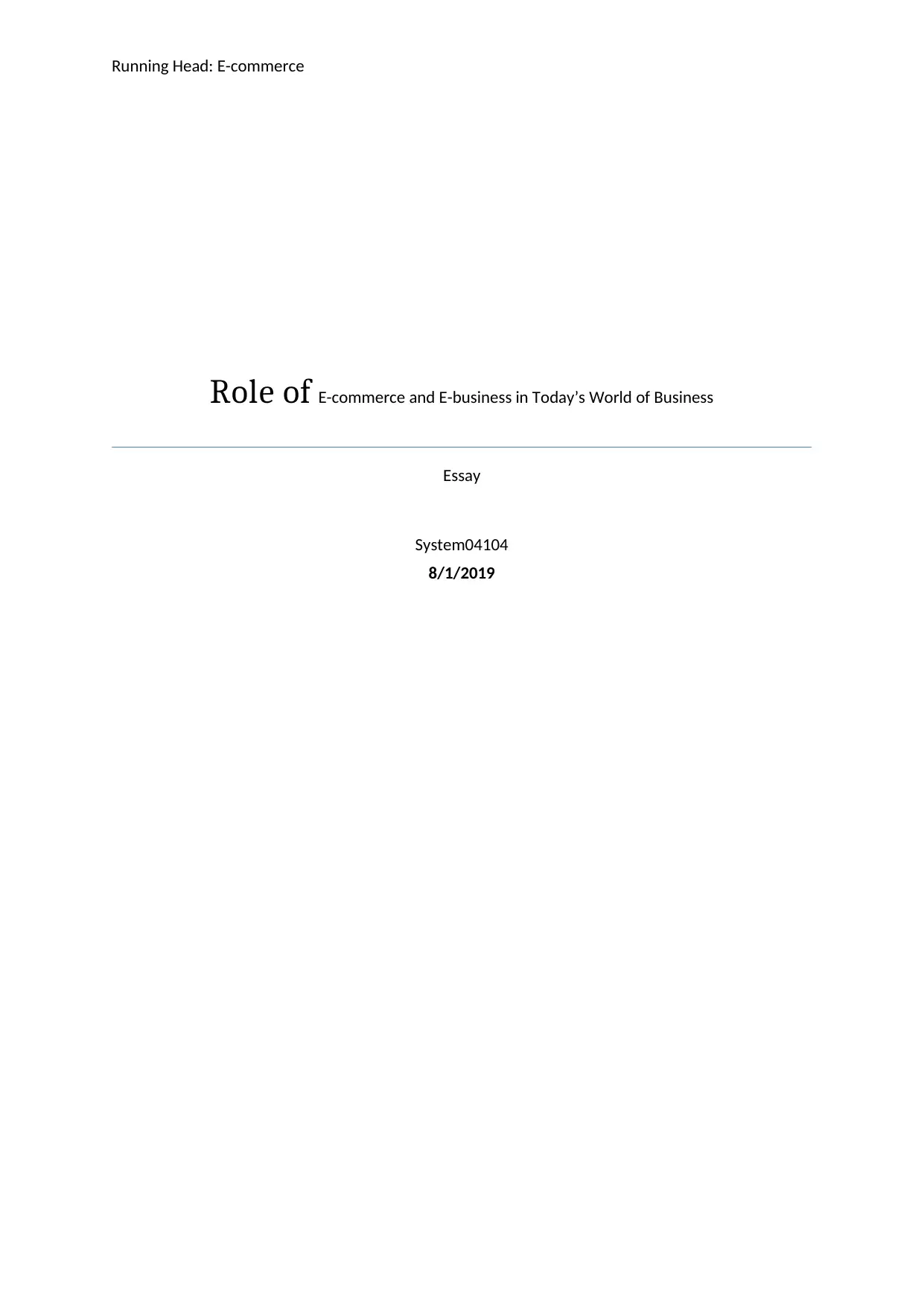
Running Head: E-commerce
Role of E-commerce and E-business in Today’s World of Business
Essay
System04104
8/1/2019
Role of E-commerce and E-business in Today’s World of Business
Essay
System04104
8/1/2019
Paraphrase This Document
Need a fresh take? Get an instant paraphrase of this document with our AI Paraphraser
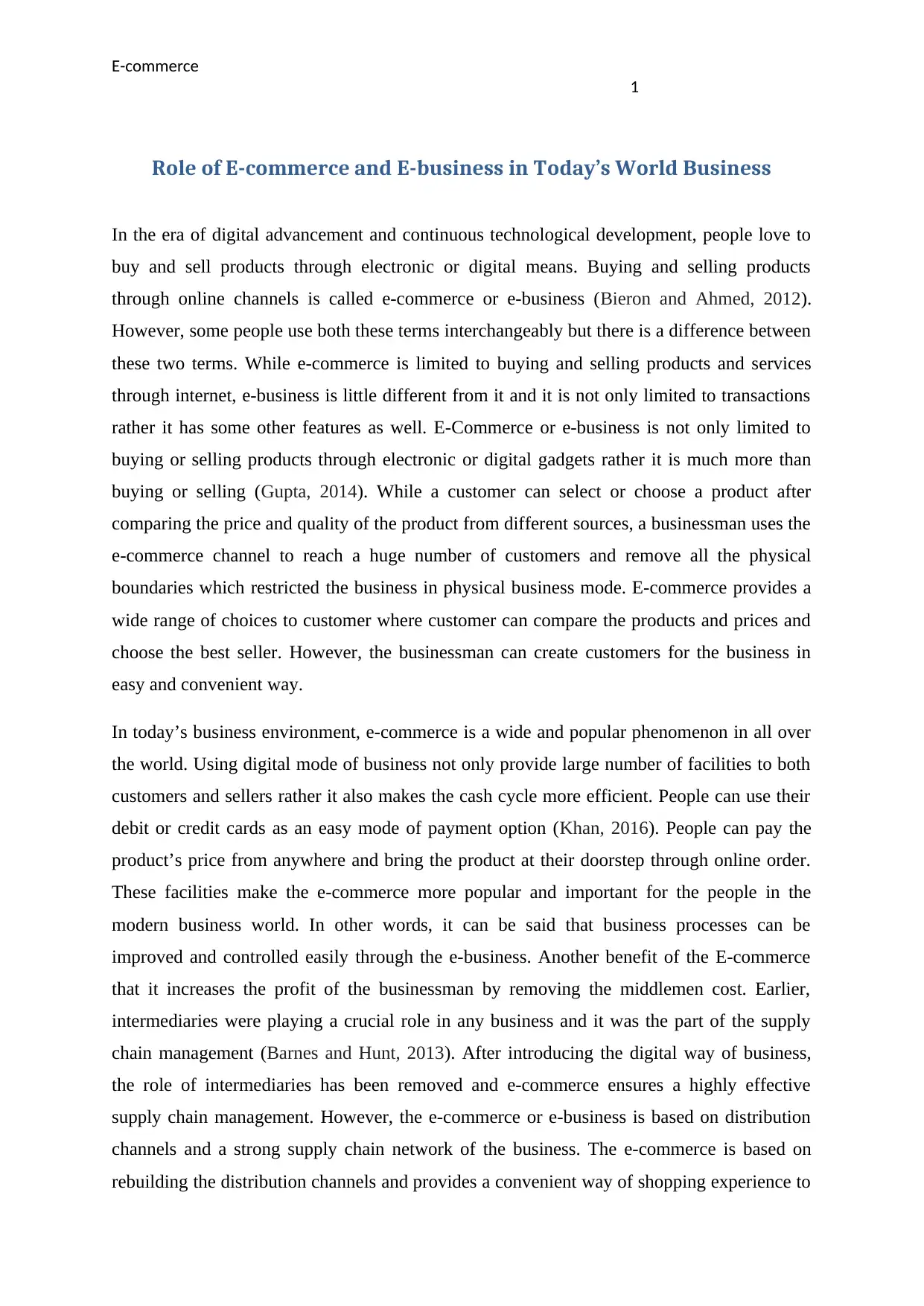
E-commerce
1
Role of E-commerce and E-business in Today’s World Business
In the era of digital advancement and continuous technological development, people love to
buy and sell products through electronic or digital means. Buying and selling products
through online channels is called e-commerce or e-business (Bieron and Ahmed, 2012).
However, some people use both these terms interchangeably but there is a difference between
these two terms. While e-commerce is limited to buying and selling products and services
through internet, e-business is little different from it and it is not only limited to transactions
rather it has some other features as well. E-Commerce or e-business is not only limited to
buying or selling products through electronic or digital gadgets rather it is much more than
buying or selling (Gupta, 2014). While a customer can select or choose a product after
comparing the price and quality of the product from different sources, a businessman uses the
e-commerce channel to reach a huge number of customers and remove all the physical
boundaries which restricted the business in physical business mode. E-commerce provides a
wide range of choices to customer where customer can compare the products and prices and
choose the best seller. However, the businessman can create customers for the business in
easy and convenient way.
In today’s business environment, e-commerce is a wide and popular phenomenon in all over
the world. Using digital mode of business not only provide large number of facilities to both
customers and sellers rather it also makes the cash cycle more efficient. People can use their
debit or credit cards as an easy mode of payment option (Khan, 2016). People can pay the
product’s price from anywhere and bring the product at their doorstep through online order.
These facilities make the e-commerce more popular and important for the people in the
modern business world. In other words, it can be said that business processes can be
improved and controlled easily through the e-business. Another benefit of the E-commerce
that it increases the profit of the businessman by removing the middlemen cost. Earlier,
intermediaries were playing a crucial role in any business and it was the part of the supply
chain management (Barnes and Hunt, 2013). After introducing the digital way of business,
the role of intermediaries has been removed and e-commerce ensures a highly effective
supply chain management. However, the e-commerce or e-business is based on distribution
channels and a strong supply chain network of the business. The e-commerce is based on
rebuilding the distribution channels and provides a convenient way of shopping experience to
1
Role of E-commerce and E-business in Today’s World Business
In the era of digital advancement and continuous technological development, people love to
buy and sell products through electronic or digital means. Buying and selling products
through online channels is called e-commerce or e-business (Bieron and Ahmed, 2012).
However, some people use both these terms interchangeably but there is a difference between
these two terms. While e-commerce is limited to buying and selling products and services
through internet, e-business is little different from it and it is not only limited to transactions
rather it has some other features as well. E-Commerce or e-business is not only limited to
buying or selling products through electronic or digital gadgets rather it is much more than
buying or selling (Gupta, 2014). While a customer can select or choose a product after
comparing the price and quality of the product from different sources, a businessman uses the
e-commerce channel to reach a huge number of customers and remove all the physical
boundaries which restricted the business in physical business mode. E-commerce provides a
wide range of choices to customer where customer can compare the products and prices and
choose the best seller. However, the businessman can create customers for the business in
easy and convenient way.
In today’s business environment, e-commerce is a wide and popular phenomenon in all over
the world. Using digital mode of business not only provide large number of facilities to both
customers and sellers rather it also makes the cash cycle more efficient. People can use their
debit or credit cards as an easy mode of payment option (Khan, 2016). People can pay the
product’s price from anywhere and bring the product at their doorstep through online order.
These facilities make the e-commerce more popular and important for the people in the
modern business world. In other words, it can be said that business processes can be
improved and controlled easily through the e-business. Another benefit of the E-commerce
that it increases the profit of the businessman by removing the middlemen cost. Earlier,
intermediaries were playing a crucial role in any business and it was the part of the supply
chain management (Barnes and Hunt, 2013). After introducing the digital way of business,
the role of intermediaries has been removed and e-commerce ensures a highly effective
supply chain management. However, the e-commerce or e-business is based on distribution
channels and a strong supply chain network of the business. The e-commerce is based on
rebuilding the distribution channels and provides a convenient way of shopping experience to
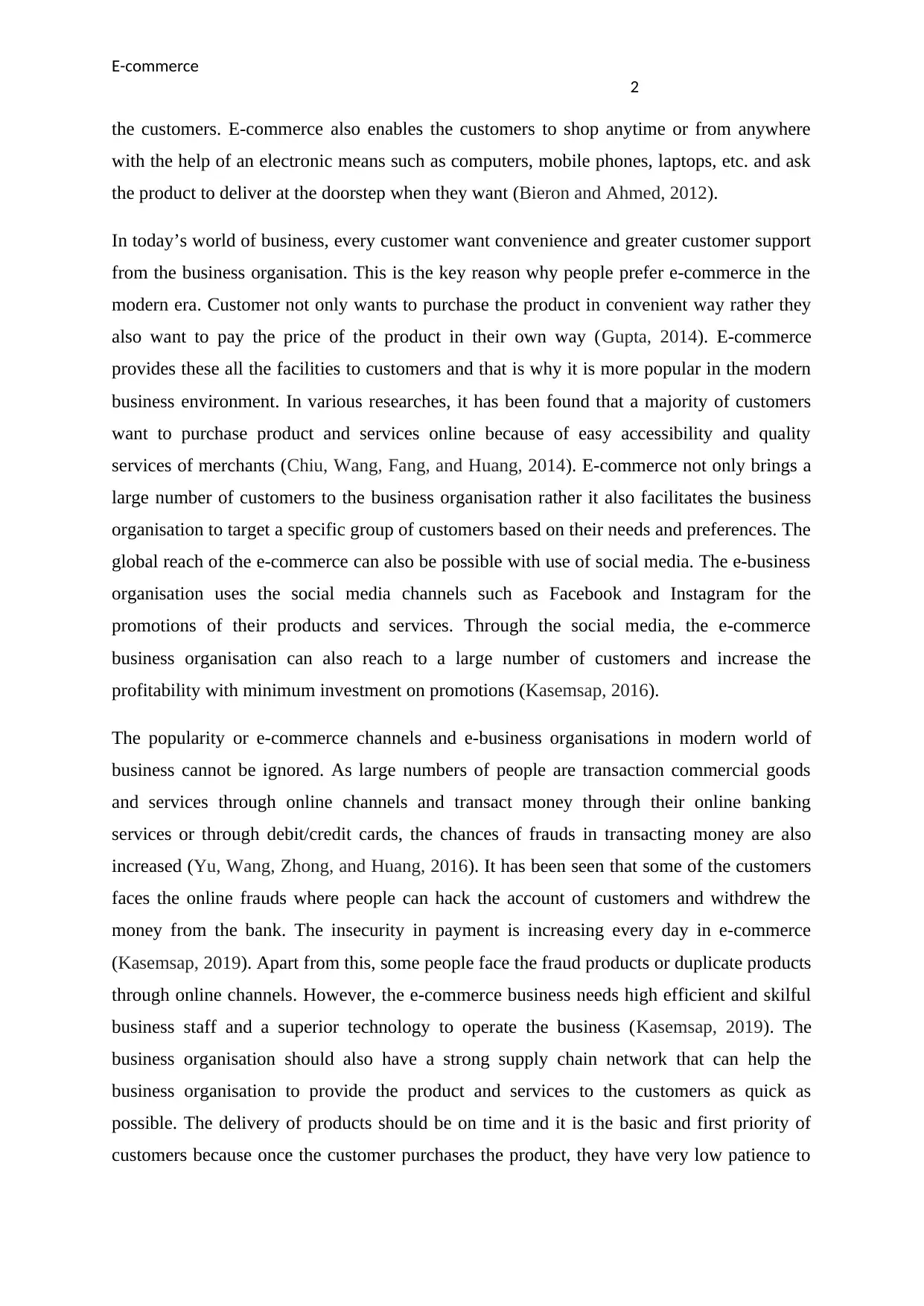
E-commerce
2
the customers. E-commerce also enables the customers to shop anytime or from anywhere
with the help of an electronic means such as computers, mobile phones, laptops, etc. and ask
the product to deliver at the doorstep when they want (Bieron and Ahmed, 2012).
In today’s world of business, every customer want convenience and greater customer support
from the business organisation. This is the key reason why people prefer e-commerce in the
modern era. Customer not only wants to purchase the product in convenient way rather they
also want to pay the price of the product in their own way (Gupta, 2014). E-commerce
provides these all the facilities to customers and that is why it is more popular in the modern
business environment. In various researches, it has been found that a majority of customers
want to purchase product and services online because of easy accessibility and quality
services of merchants (Chiu, Wang, Fang, and Huang, 2014). E-commerce not only brings a
large number of customers to the business organisation rather it also facilitates the business
organisation to target a specific group of customers based on their needs and preferences. The
global reach of the e-commerce can also be possible with use of social media. The e-business
organisation uses the social media channels such as Facebook and Instagram for the
promotions of their products and services. Through the social media, the e-commerce
business organisation can also reach to a large number of customers and increase the
profitability with minimum investment on promotions (Kasemsap, 2016).
The popularity or e-commerce channels and e-business organisations in modern world of
business cannot be ignored. As large numbers of people are transaction commercial goods
and services through online channels and transact money through their online banking
services or through debit/credit cards, the chances of frauds in transacting money are also
increased (Yu, Wang, Zhong, and Huang, 2016). It has been seen that some of the customers
faces the online frauds where people can hack the account of customers and withdrew the
money from the bank. The insecurity in payment is increasing every day in e-commerce
(Kasemsap, 2019). Apart from this, some people face the fraud products or duplicate products
through online channels. However, the e-commerce business needs high efficient and skilful
business staff and a superior technology to operate the business (Kasemsap, 2019). The
business organisation should also have a strong supply chain network that can help the
business organisation to provide the product and services to the customers as quick as
possible. The delivery of products should be on time and it is the basic and first priority of
customers because once the customer purchases the product, they have very low patience to
2
the customers. E-commerce also enables the customers to shop anytime or from anywhere
with the help of an electronic means such as computers, mobile phones, laptops, etc. and ask
the product to deliver at the doorstep when they want (Bieron and Ahmed, 2012).
In today’s world of business, every customer want convenience and greater customer support
from the business organisation. This is the key reason why people prefer e-commerce in the
modern era. Customer not only wants to purchase the product in convenient way rather they
also want to pay the price of the product in their own way (Gupta, 2014). E-commerce
provides these all the facilities to customers and that is why it is more popular in the modern
business environment. In various researches, it has been found that a majority of customers
want to purchase product and services online because of easy accessibility and quality
services of merchants (Chiu, Wang, Fang, and Huang, 2014). E-commerce not only brings a
large number of customers to the business organisation rather it also facilitates the business
organisation to target a specific group of customers based on their needs and preferences. The
global reach of the e-commerce can also be possible with use of social media. The e-business
organisation uses the social media channels such as Facebook and Instagram for the
promotions of their products and services. Through the social media, the e-commerce
business organisation can also reach to a large number of customers and increase the
profitability with minimum investment on promotions (Kasemsap, 2016).
The popularity or e-commerce channels and e-business organisations in modern world of
business cannot be ignored. As large numbers of people are transaction commercial goods
and services through online channels and transact money through their online banking
services or through debit/credit cards, the chances of frauds in transacting money are also
increased (Yu, Wang, Zhong, and Huang, 2016). It has been seen that some of the customers
faces the online frauds where people can hack the account of customers and withdrew the
money from the bank. The insecurity in payment is increasing every day in e-commerce
(Kasemsap, 2019). Apart from this, some people face the fraud products or duplicate products
through online channels. However, the e-commerce business needs high efficient and skilful
business staff and a superior technology to operate the business (Kasemsap, 2019). The
business organisation should also have a strong supply chain network that can help the
business organisation to provide the product and services to the customers as quick as
possible. The delivery of products should be on time and it is the basic and first priority of
customers because once the customer purchases the product, they have very low patience to
⊘ This is a preview!⊘
Do you want full access?
Subscribe today to unlock all pages.

Trusted by 1+ million students worldwide
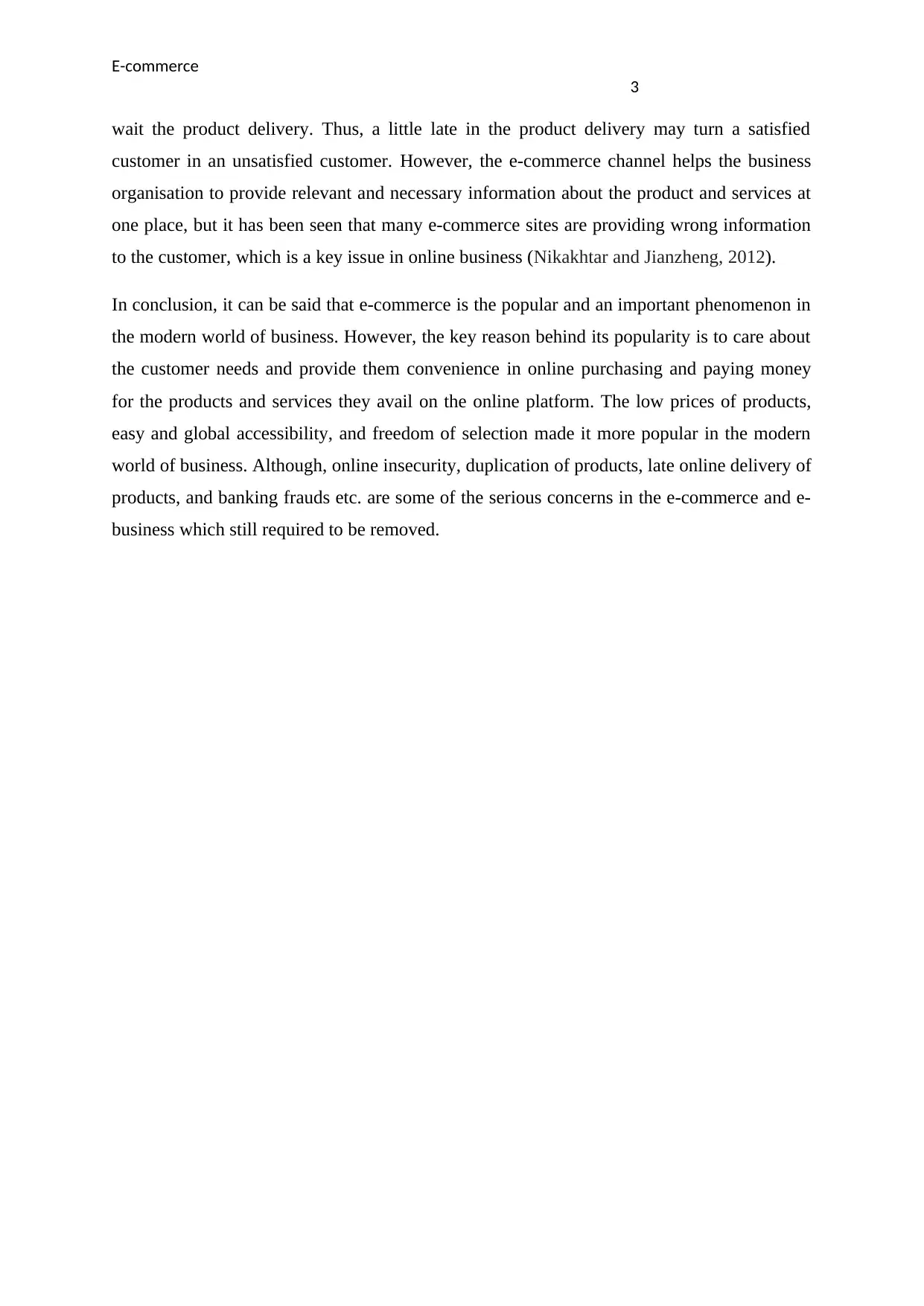
E-commerce
3
wait the product delivery. Thus, a little late in the product delivery may turn a satisfied
customer in an unsatisfied customer. However, the e-commerce channel helps the business
organisation to provide relevant and necessary information about the product and services at
one place, but it has been seen that many e-commerce sites are providing wrong information
to the customer, which is a key issue in online business (Nikakhtar and Jianzheng, 2012).
In conclusion, it can be said that e-commerce is the popular and an important phenomenon in
the modern world of business. However, the key reason behind its popularity is to care about
the customer needs and provide them convenience in online purchasing and paying money
for the products and services they avail on the online platform. The low prices of products,
easy and global accessibility, and freedom of selection made it more popular in the modern
world of business. Although, online insecurity, duplication of products, late online delivery of
products, and banking frauds etc. are some of the serious concerns in the e-commerce and e-
business which still required to be removed.
3
wait the product delivery. Thus, a little late in the product delivery may turn a satisfied
customer in an unsatisfied customer. However, the e-commerce channel helps the business
organisation to provide relevant and necessary information about the product and services at
one place, but it has been seen that many e-commerce sites are providing wrong information
to the customer, which is a key issue in online business (Nikakhtar and Jianzheng, 2012).
In conclusion, it can be said that e-commerce is the popular and an important phenomenon in
the modern world of business. However, the key reason behind its popularity is to care about
the customer needs and provide them convenience in online purchasing and paying money
for the products and services they avail on the online platform. The low prices of products,
easy and global accessibility, and freedom of selection made it more popular in the modern
world of business. Although, online insecurity, duplication of products, late online delivery of
products, and banking frauds etc. are some of the serious concerns in the e-commerce and e-
business which still required to be removed.
Paraphrase This Document
Need a fresh take? Get an instant paraphrase of this document with our AI Paraphraser
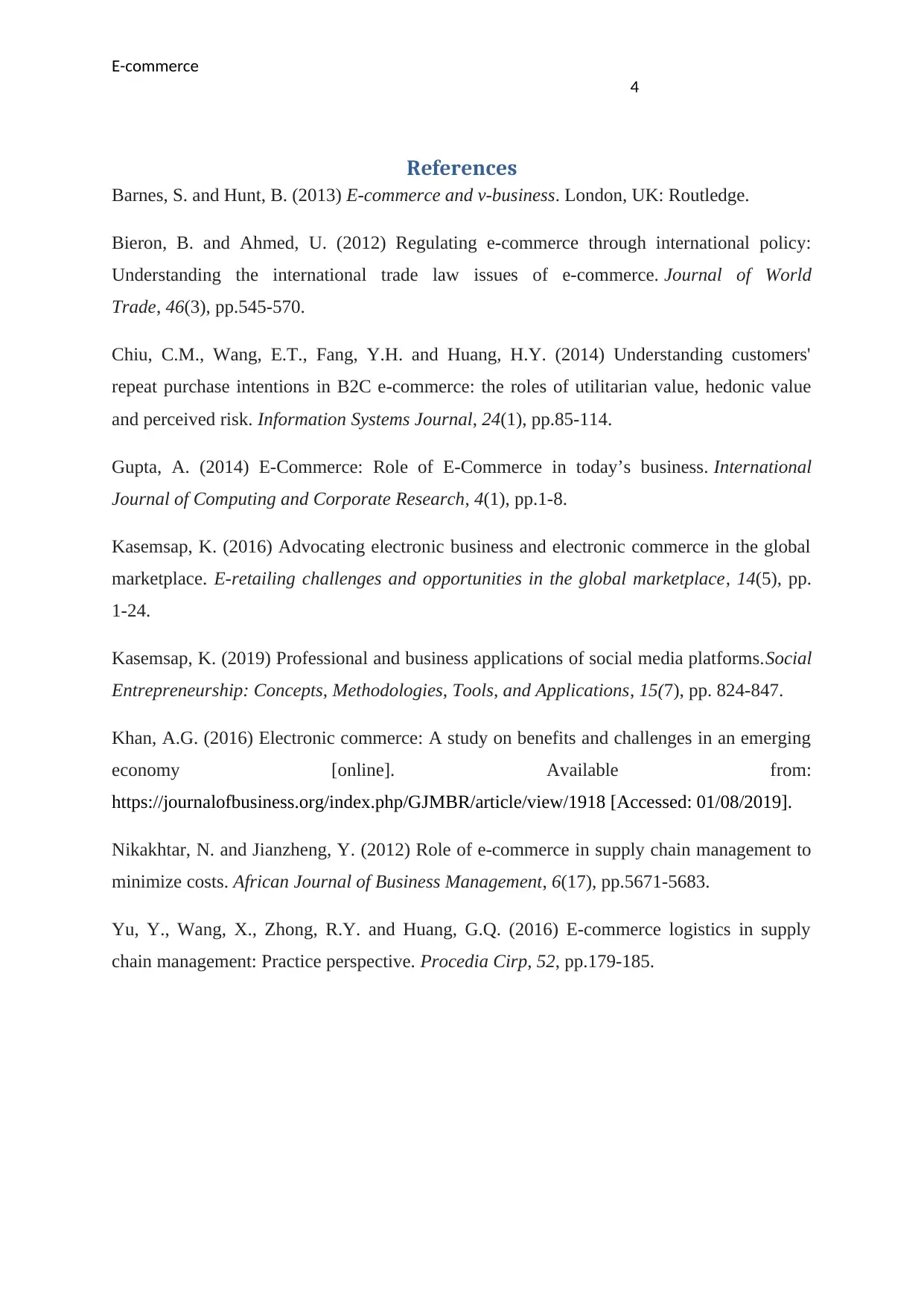
E-commerce
4
References
Barnes, S. and Hunt, B. (2013) E-commerce and v-business. London, UK: Routledge.
Bieron, B. and Ahmed, U. (2012) Regulating e-commerce through international policy:
Understanding the international trade law issues of e-commerce. Journal of World
Trade, 46(3), pp.545-570.
Chiu, C.M., Wang, E.T., Fang, Y.H. and Huang, H.Y. (2014) Understanding customers'
repeat purchase intentions in B2C e‐commerce: the roles of utilitarian value, hedonic value
and perceived risk. Information Systems Journal, 24(1), pp.85-114.
Gupta, A. (2014) E-Commerce: Role of E-Commerce in today’s business. International
Journal of Computing and Corporate Research, 4(1), pp.1-8.
Kasemsap, K. (2016) Advocating electronic business and electronic commerce in the global
marketplace. E-retailing challenges and opportunities in the global marketplace, 14(5), pp.
1-24.
Kasemsap, K. (2019) Professional and business applications of social media platforms.Social
Entrepreneurship: Concepts, Methodologies, Tools, and Applications, 15(7), pp. 824-847.
Khan, A.G. (2016) Electronic commerce: A study on benefits and challenges in an emerging
economy [online]. Available from:
https://journalofbusiness.org/index.php/GJMBR/article/view/1918 [Accessed: 01/08/2019].
Nikakhtar, N. and Jianzheng, Y. (2012) Role of e-commerce in supply chain management to
minimize costs. African Journal of Business Management, 6(17), pp.5671-5683.
Yu, Y., Wang, X., Zhong, R.Y. and Huang, G.Q. (2016) E-commerce logistics in supply
chain management: Practice perspective. Procedia Cirp, 52, pp.179-185.
4
References
Barnes, S. and Hunt, B. (2013) E-commerce and v-business. London, UK: Routledge.
Bieron, B. and Ahmed, U. (2012) Regulating e-commerce through international policy:
Understanding the international trade law issues of e-commerce. Journal of World
Trade, 46(3), pp.545-570.
Chiu, C.M., Wang, E.T., Fang, Y.H. and Huang, H.Y. (2014) Understanding customers'
repeat purchase intentions in B2C e‐commerce: the roles of utilitarian value, hedonic value
and perceived risk. Information Systems Journal, 24(1), pp.85-114.
Gupta, A. (2014) E-Commerce: Role of E-Commerce in today’s business. International
Journal of Computing and Corporate Research, 4(1), pp.1-8.
Kasemsap, K. (2016) Advocating electronic business and electronic commerce in the global
marketplace. E-retailing challenges and opportunities in the global marketplace, 14(5), pp.
1-24.
Kasemsap, K. (2019) Professional and business applications of social media platforms.Social
Entrepreneurship: Concepts, Methodologies, Tools, and Applications, 15(7), pp. 824-847.
Khan, A.G. (2016) Electronic commerce: A study on benefits and challenges in an emerging
economy [online]. Available from:
https://journalofbusiness.org/index.php/GJMBR/article/view/1918 [Accessed: 01/08/2019].
Nikakhtar, N. and Jianzheng, Y. (2012) Role of e-commerce in supply chain management to
minimize costs. African Journal of Business Management, 6(17), pp.5671-5683.
Yu, Y., Wang, X., Zhong, R.Y. and Huang, G.Q. (2016) E-commerce logistics in supply
chain management: Practice perspective. Procedia Cirp, 52, pp.179-185.
1 out of 5
Related Documents
Your All-in-One AI-Powered Toolkit for Academic Success.
+13062052269
info@desklib.com
Available 24*7 on WhatsApp / Email
![[object Object]](/_next/static/media/star-bottom.7253800d.svg)
Unlock your academic potential
Copyright © 2020–2025 A2Z Services. All Rights Reserved. Developed and managed by ZUCOL.




